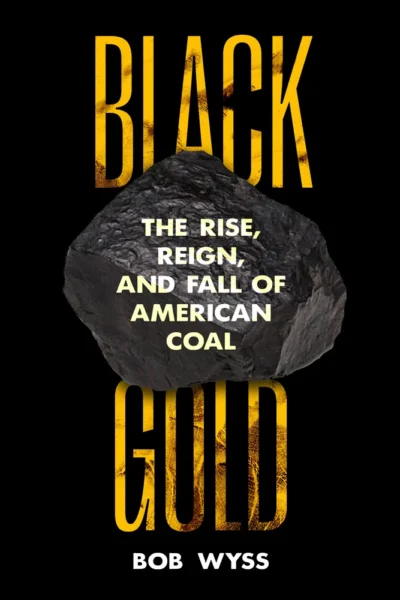
If I were to mention the words “black gold” you might picture oil (Thank you, Beverly Hillbillies).
But the original black gold was coal and it is the title of this engrossing book by journalist Bob Wyss.
Black Gold: The Rise, Reign, and Fall of American Coal takes readers on a journey that begins in the 1700s when explorers and surveyors found massive seems of exposed coal deposits along the Appalachians. And it is coal that created the America we live in today. As Wyss writes:
Coal was the magic elixir that fueled American’s Industrial Revolution. It powered the nation’s railroads, and those railroads delivered coal to the rest of the country. No corporation better represented that bond then the Pennsylvania Railroad, which grew to become the biggest, most powerful privately controlled force in the nation.
Coal and railroads were the yin and yang of industrialization. Coal was needed to forge the steel that expanded the reach of railroads and 65% of the cargo carried by trains was coal. Most early railways were built primarily to carry coal, not people. And the Pennsylvania Railroad become so large that its budget was second only in size to the US government.
The plight of of miners is painful to read about. The numerous coal mine disasters, the dead numbering in the hundreds at a time. In Centralia, Illinois, 111 miners died in 1947 from an explosion that could have been avoided had management simply heeded warnings and actually cared about its employees. But the owners of the mines, the first wave of massively wealthy Americans, did not care about workers. So coal also fueled the rise of unions and epic, ongoing battles between workers and management.
The book is organized chronologically. We begin by learning the origins of coal — a process that began more than 300 million years ago from the remains of ancient swamps and vegetation compressed over the ages into carbon. We also learn the different types of coals, such as coke and anthracite and why these hotter-burning forms of coal led to the production of steel, which led to train tracks and the infrastructure of the county. We get to know JP Morgan and Andrew Carnegie. And their stories of insatiable greed will ring eerily familiar to the exploits of our current crop of billionaires. And, yes, government was largely bought and paid for as well.
And then there is the smoke. Growing up, I felt like I received a better education about the smoke in London than in my hometown of St. Louis, which was so shrouded in pollution that in November 1939, visibility was less than two feet and the polar bears in the St. Louis zoo turned the color of brown grizzlies. St. Louis was far from alone. Wyss writes:
For more than a century, many cities across America had struggled with often dense clouds of smoke from coal burning. Most citizens shrugged off the pollution, accepting it as a price of commerce and industry. In New York City, smoke sometimes obscured the Statue of Liberty from the shores of the battery.
In this book I discovered the origin of Mother Jones, the Molly Maguires and why the Frick Museum carries that name. I only wish we could have learned more about the animals who played a role in the rise of coal, like the pit ponies and the canaries (sold to miners in company stores).
Coal is still very much in use today; there are roughly 200 power plants still using coal right now. But it is no longer a major employer. In 2020, just 63,000 people worked in mining vs. more than 800,000 in 1923. Anyone who thinks coal represents the “good ol’ days” should read this book; it is a powerful reminder of how many people suffered and died to power a country and keep it warm during the winter.
John is co-author, with Midge Raymond, of the mystery Devils Island. He is also author of the novels The Tourist Trail and Where Oceans Hide Their Dead. Co-founder of Ashland Creek Press and editor of Writing for Animals (also now a writing program). More at JohnYunker.com.
